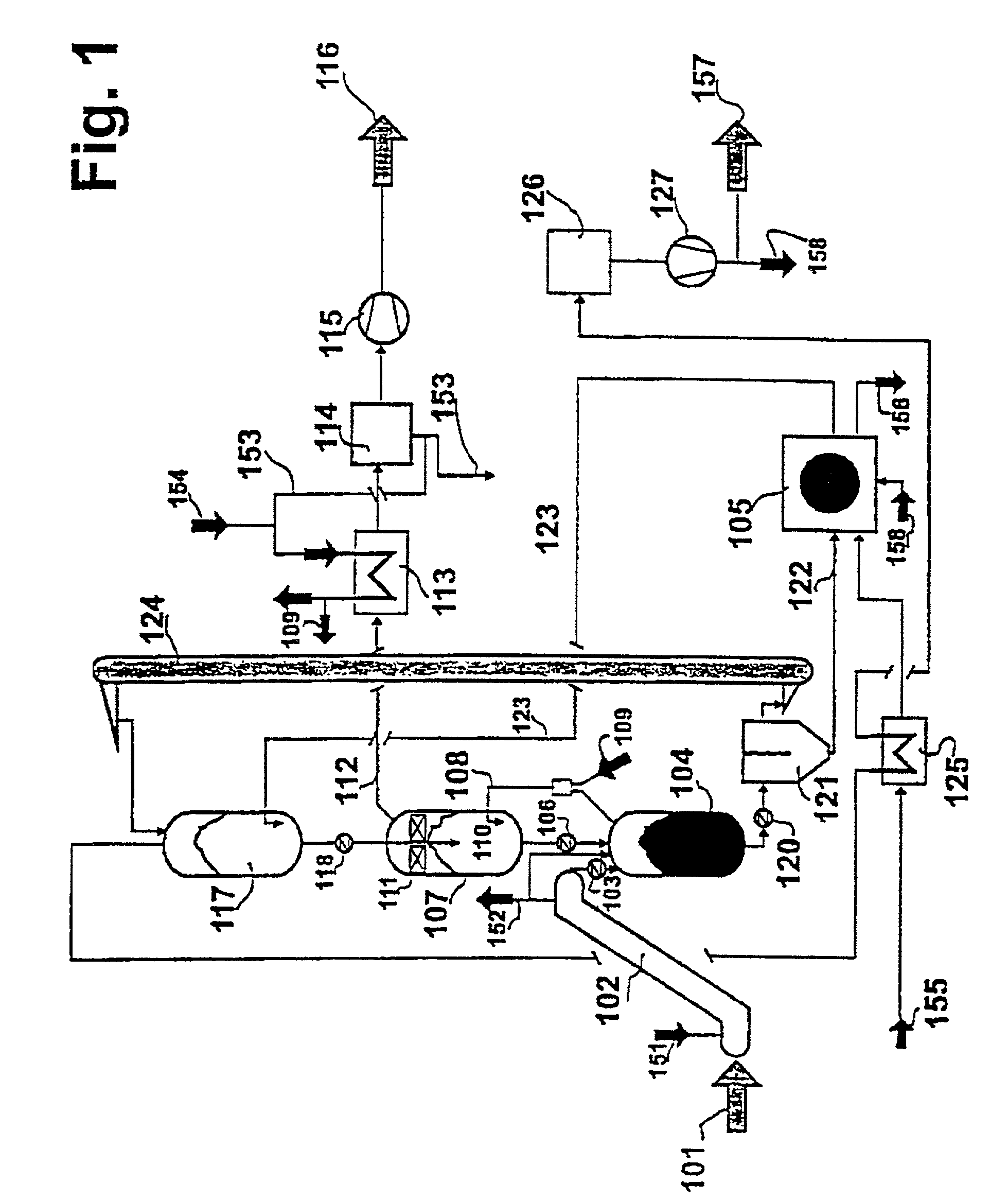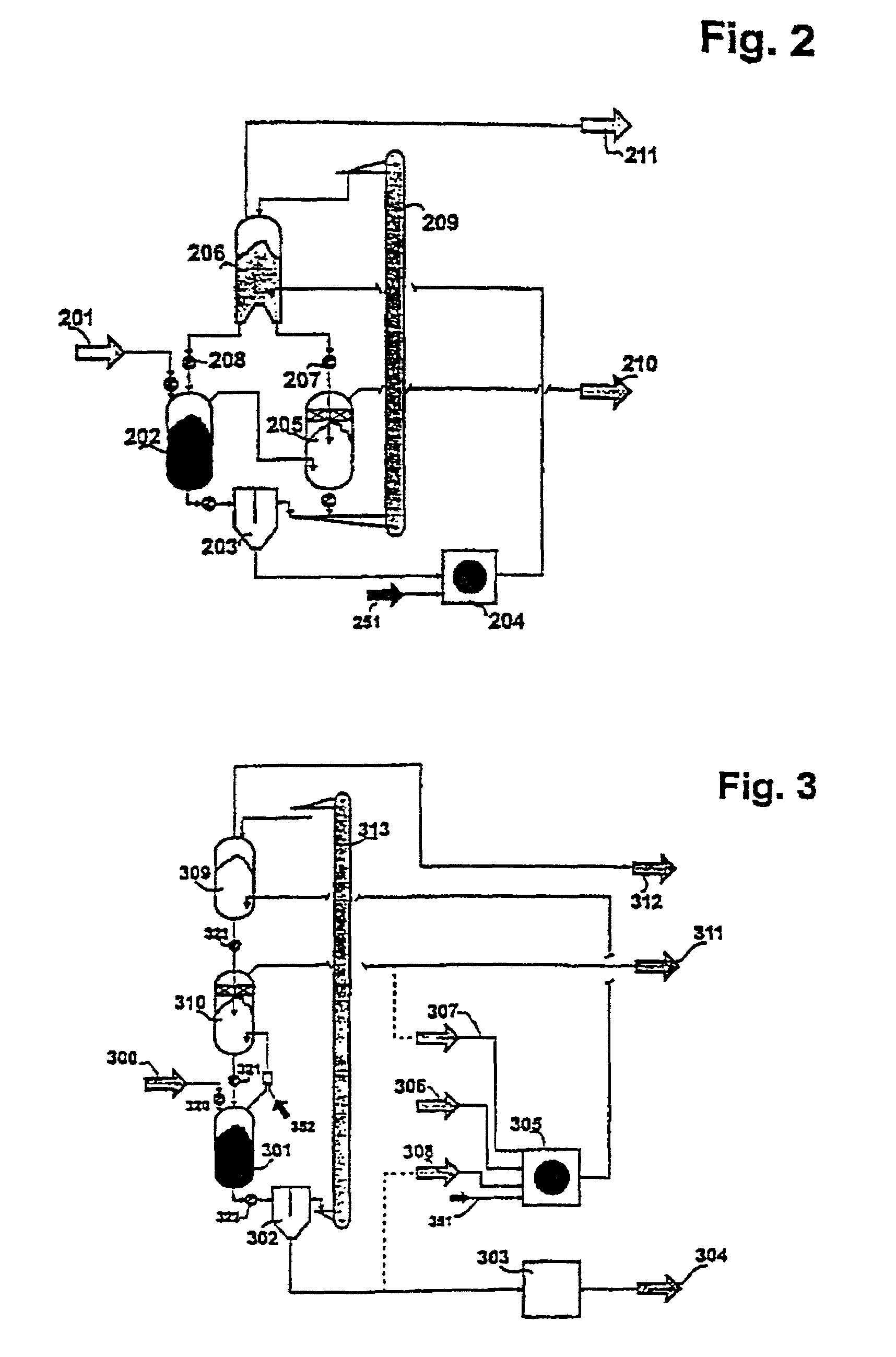[0012]The invention is based on the problem of providing a method that can be carried in a simple way for producing a high-quality and undiluted
product gas with a high calorific value; with low expenditure for the equipment; and in which, furthermore, the use of fluidized beds or heat exchangers having high temperatures on both sides is avoided, and in which the heat is transferred from the firing stage into the heat-carrying medium in a particularly defined manner.
[0015]According to the invention, the pyrolysis of the organic substance is carried out in a reactor that permits converting the heat required for the heating up, and the
drying steps and the pyrolysis to be carried out in a manner as effectively as possible, in conjunction with the greatest possible simplicity in terms of equipment requirements, and a robust mode of operation. Consequently a migrating
bed-type reactor or a
rotating drum are considered for this task, as a rule. The pyrolysis temperature will then preferably be in a range of from 500° to 650° C.
[0020]According to the invention, the method of the invention opens up at least two basic possibilities for controlling the circulation of the heat-carrying medium. With respect to the heat-carrying medium, it is possible to successively connect the second
reaction zone and the pyrolysis reactor one after the other, in series or in parallel. The important
advantage offered by the series connection lies in the simplicity of the equipment: the heating-up zone, the second
reaction zone and the pyrolysis reactor are interconnected among each other, so that the heat-carrying medium is moving through this arrangement, driven by force of gravity from the top downwards. Versus the arrangement described in (2), the pyrolysis stage has been changed to the extent that the pyrolysis no longer needs to be carried out with a very much greater amount of heat-carrying medium having, however, a distinctly lower temperature. If, for example, the heat-carrying medium enters the second
reaction zone for the reforming purpose with a temperature of around 1050° C., it will exit from said zone while still having temperature of only about 750° C. With the parallel connection, the pyrolysis stage is not changed vis-à-vis the arrangement described in (2). However, a higher expenditure in terms of equipment has to be expected due to the fact the hot
stream of heat-carrying medium has been divided, allocating it to the pyrolysis reactor and the second reaction zone, and is subsequently united again. The parallel connection, therefore, has to be given preference in cases in which it is advantageous if the charged material comes into contact with particularly hot heat-carrying medium.
[0021]Finally, the addition of process steam to the pyrolysis gases prior to the reforming step is carried out in the second reaction zone. This is addressed in the following as well. The process steam has to be admixed in an excess amount with respect to the homogeneous reactions occurring in the
gas phase that have to be expected to occur, because any possible formation of
carbon black can be consequently suppressed only in this way. A basis for this consists in maintaining a defined steam concentration in the fresh
product gas, specifically amounting to, for example 20% by volume or more. On the other hand, it has to be expected that controlling the addition of process steam quantitatively with a steam concentration serving as the measuring quantity will require a great deal of expenditure and will be costly. It is deemed to be better to adjust a fixed value that is controlled via a measurement of the quantity depending on the capacity, which possibly may be carried out in any case. One possibility for realizing the method as defined by the invention that needs to be mentioned in any case lies in the selection of the site where the process steam is mixed with the pyrolysis gas. This mixing process has to take place prior to the entry of the mixture into the second reaction zone of the reformer at the latest; however, said site may be shifted upstream to the pyrolysis reactor, and there to any desired location within the pyrolysis reactor situated up to its lower end. The lower end of the pyrolysis reactor is meant in this connection to be the site from where the mixture comprising the heat-carrying medium and the solid, carbon-containing residue exits. This does change the division of the heat realized between the pyrolysis and the reforming stages; however, flushing of the pyrolysis with steam, which is added within the vicinity of the site where the solids exit from the pyrolysis reactor, offers advantages in the last analysis under a number of aspects: firstly, the temperature of the pyrolysis gas is not lowered in this way at any point on its way to the second reaction zone, so no condensation has to be expected to occur. Secondly, it is known from (3) that it is possible to increase the yield of volatile components in the pyrolysis of biomasses by rinsing with steam. This can be advantageous because an excessively high yield of solid pyrolysis product beyond the heat requirement of the method will reduce the yield of product gas and in connection therewith the degree of efficiency of the cold gas. Thirdly and finally, this constitutes a preventive measure for avoiding possible leakage of pyrolysis gas in the direction of the separation stage, where the heat-carrying medium and the pyrolysis gas are separated.
 Login to View More
Login to View More  Login to View More
Login to View More 

